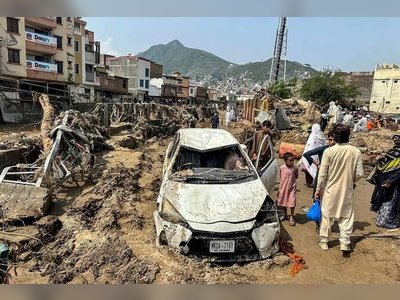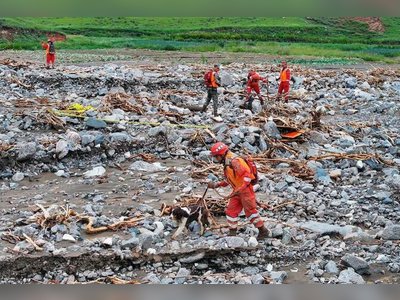
From Drought to Floods, Water Extremes Drive Displacement in Afghanistan
Climate change-fueled shocks displace Afghans as water scarcity and devastating floods strain livelihoods.
Kabul, Afghanistan: Next to small bundles of belongings, Maruf waited for a car to take him and his family away from their village in northern Afghanistan, where drought-ridden land had yielded nothing for years.
The 50-year-old expressed the desperation felt by many when he said, "When you have children and are responsible for their needs, then tell me, what are you still doing in this ruin?" Many of the mud homes around him are already empty, as neighbors have abandoned the village due to "thirst, hunger and a life with no future." Successive wars had displaced Afghans over 40 years, but peace has not brought total reprieve, as climate change-fueled shocks drive people from their homes and strain livelihoods.
Since the war ended between the now-ruling Taliban and US-led forces in 2021, floods, droughts, and other environmental hazards have become the main cause of displacement in the country, according to the UN’s International Organization for Migration (IOM).
In early 2025, nearly five million people across the country were impacted by these climate-related events, with nearly 400,000 people displaced, as cited by the IOM in July.
The majority of Afghans live in mud homes and depend heavily on agriculture and livestock, making them particularly exposed to environmental changes.
The water cycle has been sharply impacted, with Afghanistan experiencing drought for the fourth time in five years and flash floods devastating land, homes, and livelihoods.
"Crop failure, dry pastures, and vanishing water sources are pushing rural communities to the edge," said the UN Food and Agriculture Organization in July.
"It’s getting harder for families to grow food, earn income or stay where they are." Experts and Taliban officials have repeatedly warned of escalating climate risks as temperatures rise, extreme weather events intensify, and precipitation patterns shift.
The country's limited infrastructure, endemic poverty, and international isolation leave Afghans with few resources to adapt and recover while already facing one of the world’s worst humanitarian crises worsened by severe aid cuts.
Abdul Jalil Rasooli's village in the drought-hit north has watched their way of life wither away along with their crops.
Drought had previously driven many from his village to Pakistan and Iran a decade ago, but they have now returned due to increased migration over the border since late 2023.
The returnees are forced to work odd jobs rather than cultivating the land.
Rasooli expressed hope for relief from the nearby Qosh Tepa canal, which will bring irrigation from the Amu Darya river.
However, its completion is more than a year away, according to officials.
Taliban authorities have undertaken several water infrastructure projects since ousting the foreign-backed government four years ago.
The water scarcity has pushed Afghans like Hamayoun Amiri to seek employment in neighboring countries after being deported due to drought.
Upon returning, he found that his father's well water was rapidly depleting.
In some regions of Afghanistan, rains have become more destructive due to changes in precipitation patterns and above-average temperatures.
A warmer atmosphere holds more water, resulting in massive rain events that often cause devastating floods.
Community leader Mohammad Qasim stated that the changing weather has never been as problematic as it is now.
The displacement caused by these climate-driven events leaves families without homes or means to rebuild after each flood, as seen in the case of 18-year-old Wahidullah and his family.
They currently reside in a makeshift tent on high ground, anxiously waiting for the next potential flood that could displace them once again.
The 50-year-old expressed the desperation felt by many when he said, "When you have children and are responsible for their needs, then tell me, what are you still doing in this ruin?" Many of the mud homes around him are already empty, as neighbors have abandoned the village due to "thirst, hunger and a life with no future." Successive wars had displaced Afghans over 40 years, but peace has not brought total reprieve, as climate change-fueled shocks drive people from their homes and strain livelihoods.
Since the war ended between the now-ruling Taliban and US-led forces in 2021, floods, droughts, and other environmental hazards have become the main cause of displacement in the country, according to the UN’s International Organization for Migration (IOM).
In early 2025, nearly five million people across the country were impacted by these climate-related events, with nearly 400,000 people displaced, as cited by the IOM in July.
The majority of Afghans live in mud homes and depend heavily on agriculture and livestock, making them particularly exposed to environmental changes.
The water cycle has been sharply impacted, with Afghanistan experiencing drought for the fourth time in five years and flash floods devastating land, homes, and livelihoods.
"Crop failure, dry pastures, and vanishing water sources are pushing rural communities to the edge," said the UN Food and Agriculture Organization in July.
"It’s getting harder for families to grow food, earn income or stay where they are." Experts and Taliban officials have repeatedly warned of escalating climate risks as temperatures rise, extreme weather events intensify, and precipitation patterns shift.
The country's limited infrastructure, endemic poverty, and international isolation leave Afghans with few resources to adapt and recover while already facing one of the world’s worst humanitarian crises worsened by severe aid cuts.
Abdul Jalil Rasooli's village in the drought-hit north has watched their way of life wither away along with their crops.
Drought had previously driven many from his village to Pakistan and Iran a decade ago, but they have now returned due to increased migration over the border since late 2023.
The returnees are forced to work odd jobs rather than cultivating the land.
Rasooli expressed hope for relief from the nearby Qosh Tepa canal, which will bring irrigation from the Amu Darya river.
However, its completion is more than a year away, according to officials.
Taliban authorities have undertaken several water infrastructure projects since ousting the foreign-backed government four years ago.
The water scarcity has pushed Afghans like Hamayoun Amiri to seek employment in neighboring countries after being deported due to drought.
Upon returning, he found that his father's well water was rapidly depleting.
In some regions of Afghanistan, rains have become more destructive due to changes in precipitation patterns and above-average temperatures.
A warmer atmosphere holds more water, resulting in massive rain events that often cause devastating floods.
Community leader Mohammad Qasim stated that the changing weather has never been as problematic as it is now.
The displacement caused by these climate-driven events leaves families without homes or means to rebuild after each flood, as seen in the case of 18-year-old Wahidullah and his family.
They currently reside in a makeshift tent on high ground, anxiously waiting for the next potential flood that could displace them once again.











